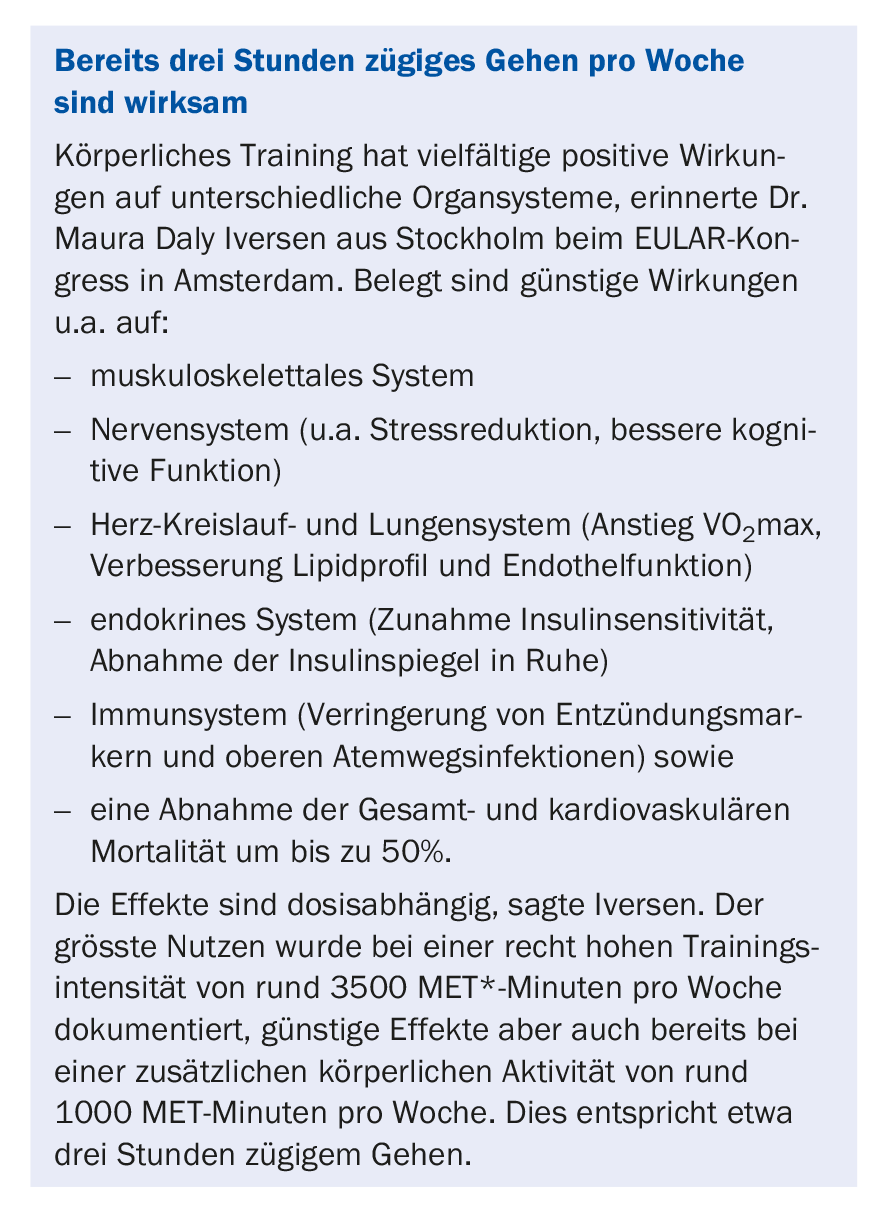“Preventing osteoarthritis is possible!” was the title of a symposium at the European League Against Rheumatism (EULAR) 2018 Annual Congress in Amsterdam.
More and more people suffer from osteoarthritis with increasing age. The results of a study published about a year ago, in which skeletons from prehistoric times (gatherers and hunters) as well as the age of the Industrial Revolution (1904-1940) and modern industrial society (1976-2015) were examined, caused a sensation. While the incidence of knee osteoarthritis in cadavers from the two earlier periods was similar at 5-10%, the proportion in modern humans aged 50 years and older was about 15% [2]. Even after accounting for age, gender, ethnic group and body mass index (BMI), the large differences between today and in the past remained, reported Professor David Felson, M.D., of Boston, who was involved in the study. Nevertheless, it is mainly the increase in obesity and physical inactivity that is under discussion as the cause of the doubling of the prevalence of knee osteoarthritis.
Between 1960 and 2008, the percentage of obese adults in the U.S. increased from 12% to 30%, Felson pointed out. The result is not only increased joint stress due to body weight and promotion of local inflammatory reactions, but often also metabolic syndrome with low-grade systemic inflammatory reactions. Cardiometabolic factors such as hypertension, elevated triglycerides, or low HDL cholesterol may contribute to cartilage damage via modulation of cytokines and other effector molecules, the epidemiologist explained. He referred to studies that suggested an increased prevalence of osteoarthritis in patients with metabolic syndrome, some of which were adjusted for BMI.
Physical inactivity can promote joint osteoarthritis via other factors besides weight gain. Felson cited decrease in muscle strength and lack of stress on joints as influencing factors, as well as depression and increased sensitivity to pain, which could promote painful osteoarthritis. Last-not-least: A so-called modern diet (“western diet”) with little fruit and vegetables (low intake of vitamins C, E and K as well as sulforaphane, e.g. from broccoli), little fiber and few omega-3 fatty acids can contribute to the progression of osteoarthritis. Low vitamin K levels and low fiber intake have already been associated with osteoarthritis, Felson said. His conclusion: weight reduction and an active lifestyle are relevant to the prevention of osteoarthritis; more research is desirable on the protective effect of diet, he said.
Daily physical activity is the key to preventing osteoarthritis, also emphasized Professor Martin Englund, M.D., an orthopedic surgeon at Lund University in Sweden. “Joints need to be used to keep them healthy,” he said. The important thing, he says, is to choose the right sport that suits your personality and to practice it at the right intensity. The correct measure of health-promoting exercise is the basic rule stated in many prevention guidelines: 150 minutes per week of moderate or 75 minutes of intense physical activity.
Regular physical activity is also very important in the therapy of osteoarthritis patients. “Physical exercise should be considered not only as a health-promoting adjunct, but as a standard intervention for both osteoarthritis and inflammatory arthritides,” said Professor Karin Niedermann, M.D., of the Institute of Physiotherapy at the University of Zurich in Winterthur. Physical training is usually suitable, effective and safe even for rheumatism patients, he said.
Niedermann is part of the EULAR task force that developed new recommendations for physical activity in rheumatoid arthritis patients based on a literature review. They were first presented at the 2018 Annual Congress in Amsterdam and recently published [3]. In physical training studies, rheumatoid arthritis patients, similar to healthy individuals, improved primarily cardiovascular fitness and muscle strength. The effects were found to be moderate, reported Anne-Kathrin Rausch, a doctoral student at the University of Zurich and also a member of the task force. However, no significant effects were observed in flexibility or neuromotor performance. There were no negative effects.

MET= Metabolic Equivalent. A MET refers to the energy expended while sitting at rest. Fast walking is equivalent to about 6 METs.
Using the data, task force members established four overarching principles and 10 practical recommendations for rheumatology patients in practice. Key points:
- Recommendation of physical activity should be an integral part of the treatment of rheumatoid arthritis patients.
- When implementing training, patients’ abilities and preferences and disease-specific contraindications should be considered.
- The type, frequency, intensity and duration of training should be determined individually.
- Goals or target values of the intervention should be set, which should also be reviewed regularly during the training.
Country-specific implementation strategies will be used to implement these recommendations in the future, Niedermann reported. Lay versions of the recommendations should also help. It is currently unclear whether the recommendations should apply in the same way to patients with rheumatoid arthritis and high cardiovascular risk. A pilot study is underway to evaluate this, reported Dr. Michael Nurmohamed from Amsterdam. Intense exercise is not recommended for this patient group. In this context, the rheumatologist referred to the EULAR recommendations on cardiovascular risk management in patients with inflammatory rheumatic diseases [4].
Sources:
- Presentation “Prevention of OA: Yes we can!”, EULAR Congress, June 15, 2018, Amsterdam.
- Wallace I, Worthington S, Felson D, et al: PNAS 2017; 114(35): 9332-9336.
- “Recommendations for physical activity in people with inflammatory arthritis and osteoarthritis,” EULAR Congress, June 14, 2018, Amsterdam. Ann Rheum Dis 2018, epub July 11, doi:10.1136/annrheumdis-2018-213585.
- Agca R, et al: EULAR recommendations for cardiovascular disease risk management in patients with rheumatoid arthritis and other forms of inflammatory joint disorders: 2015/2016 update. Ann Rheum Dis 2017; 76: 17-28.
HAUSARZT PRAXIS 2018; 13(8): 44-45











